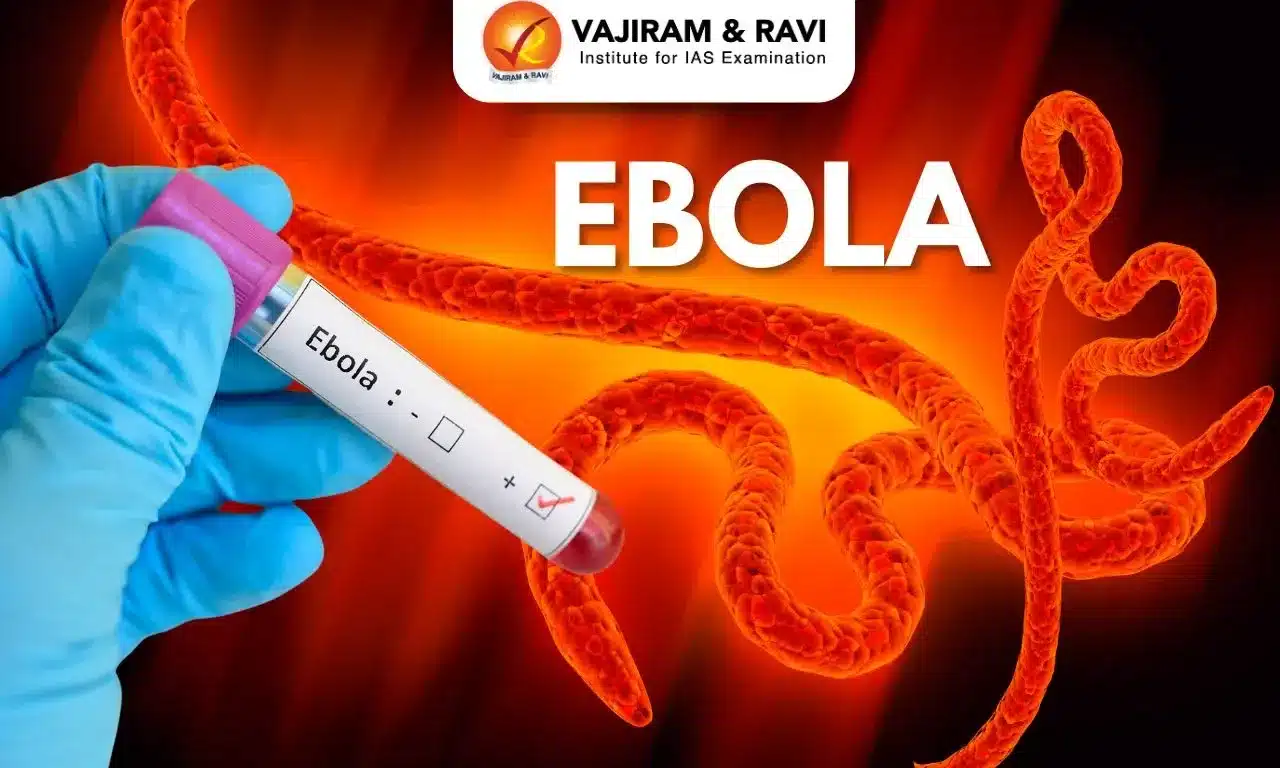Ebola Latest News
An Ebola outbreak in the Democratic Republic of Congo is now over, Congolese health officials and the U.N.’s World Health Organization said recently, after the country went 42 consecutive days without recording a new case.
About Ebola
- It is a severe and often deadly disease caused by a group of viruses known as orthoebolaviruses (formally ebolavirus).
- Orthoebolaviruses were discovered in 1976 in the Democratic Republic of the Congo and are found primarily in sub-Saharan Africa.
- It is known as a hemorrhagic fever virus because it can cause problems with the clotting system of the body and lead to internal bleeding as blood leaks from small blood vessels.
- Six different species of the virus have been found, but only four are known to cause disease in humans.
- It gets its name from the Ebola River, which is near one of the villages in the Democratic Republic of Congo where the disease first appeared.
- Ebola can occur in humans and other primates (gorillas, monkeys, and chimpanzees).
- Transmission:
- The virus is transmitted to people from wild animals (such as fruit bats, porcupines, and non-human primates) and then spreads in the human population through direct contact with the blood, secretions, organs, or other bodily fluids of infected people and with surfaces and materials (e.g., bedding, clothing) contaminated with these fluids.
- Ebola cannot be transmitted by air.
- Symptoms:
- It includes fever, diarrhea, vomiting, bleeding, and often, death.
- The average Ebola disease case fatality rate is around 50%. Case fatality rates have varied from 25–90% in past outbreaks.
- Treatment:
- There is no known cure for Ebola. Experimental treatments have been used, but none have been fully tested to see if they work well and are safe.
- For example, there are two FDA-approved monoclonal antibody treatments for the Ebola Zaire strain (Inmazeb and Ebanga).
- Recovery seems to depend in part on how much virus a person was initially exposed to, how early treatment is started, and the patient’s age and immune response.
- Current therapy consists of maintenance of fluid and electrolyte balance and the administration of blood and plasma to control bleeding.
Source: LM
Last updated on December, 2025
→ Check out the latest UPSC Syllabus 2026 here.
→ Join Vajiram & Ravi’s Interview Guidance Programme for expert help to crack your final UPSC stage.
→ UPSC Mains Result 2025 is now out.
→ UPSC Notification 2026 is scheduled to be released on January 14, 2026.
→ UPSC Calendar 2026 is released on 15th May, 2025.
→ The UPSC Vacancy 2025 were released 1129, out of which 979 were for UPSC CSE and remaining 150 are for UPSC IFoS.
→ UPSC Prelims 2026 will be conducted on 24th May, 2026 & UPSC Mains 2026 will be conducted on 21st August 2026.
→ The UPSC Selection Process is of 3 stages-Prelims, Mains and Interview.
→ UPSC Result 2024 is released with latest UPSC Marksheet 2024. Check Now!
→ UPSC Prelims Result 2025 is out now for the CSE held on 25 May 2025.
→ UPSC Toppers List 2024 is released now. Shakti Dubey is UPSC AIR 1 2024 Topper.
→ UPSC Prelims Question Paper 2025 and Unofficial Prelims Answer Key 2025 are available now.
→ UPSC Mains Question Paper 2025 is out for Essay, GS 1, 2, 3 & GS 4.
→ UPSC Mains Indian Language Question Paper 2025 is now out.
→ UPSC Mains Optional Question Paper 2025 is now out.
→ Also check Best IAS Coaching in Delhi
Ebola FAQs
Q1. What is Ebola?+
Q2. Ebola is caused by which group of viruses?+
Q3. Can Ebola be transmitted through air?+
Q4. What is the average case fatality rate of Ebola?+
Tags: ebola prelims pointers upsc current affairs upsc prelims current affairs

















